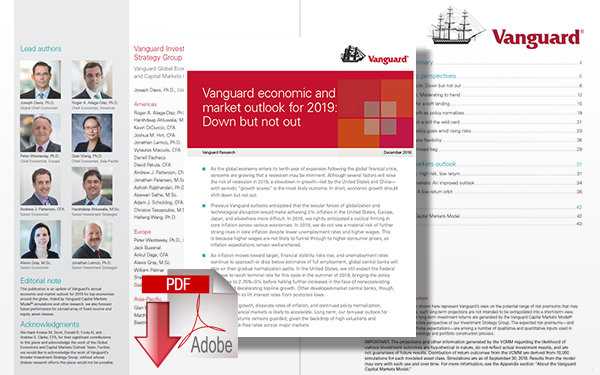IHS Markit Chief Economist Nariman Behravesh Predicts Slowdown in Global Economy in 2019

Global economic growth will edge down to 3.0 percent in 2019, from a rate of 3.2 percent in 2018, according to the annual Top 10 Economic Predictions released by business information provider IHS Markit.
Slowdown in Global Economy
Global economic growth will edge down to 3.0 percent in 2019, from a rate of 3.2 percent in 2018, according to the annual Top 10 Economic Predictions released by business information provider IHS Markit (Nasdaq: INFO).
While global growth will continue to decelerate, the economy will also become increasingly vulnerable to shocks.
According to Nariman Behravesh, chief economist at IHS Markit, growth in the U.S. will remain “above trend,” while other key economies will experience further deceleration.
Supply chain managers may face mixed blessings on the domestic front, based on estimates of sustainable growth in the labor force and productivity.
IHS Markit assesses the potential growth in the U.S. economy to be around 2.0%.
In 2018, U.S. growth was a well-above-trend 2.9%, compared with only 2.2% in 2017.
What's Coming in 2019
Global growth will edge down from 3.2% in 2018 to 3.0% in 2019-and will keep decelerating over the next few years.
The risk of an escalation in trade conflicts remains high, and if such an escalation were to occur, a contraction in world trade could slow the world economy even more.
At the same time, the sell-off in equity and commodity markets, on top of the gradual removal of stimulus by some central banks, means that financial conditions worldwide are tightening.
Combined with heightened political uncertainty, these risks point to a greater probability of a recession in the next few years.
Top 10 Economic Predictions for 2019
1) US growth will remain above trend with economic fundamentals remaining fairly solid.
In 2018, US growth was a well-above-trend at 2.9%, with the acceleration almost entirely due to a large dose of fiscal stimulus (tax cuts and spending increases) put in place at the beginning of the year. The impact of this stimulus will still be felt in 2019, but with diminishing potency as the year progresses. As a result, we expect growth of 2.6%-less than in 2018, but still above trend.
2) Europe's expansion will slow even more.
Eurozone growth was 1.9% in 2018, and we predict a further decline to 1.5% in 2019. A number of adverse economic and political factors will negatively impact growth, including less accommodative credit conditions, heightened trade tensions, the deceleration in world trade growth, and the appreciation of the euro. Anxiety about politics is certain to remain high in 2019 as events in France, Italy and Germany contribute to the rise in political uncertainty. In addition, the continuing turmoil around Brexit will hurt UK growth, which will fall to 1.1% in 2019.
3) Japan's recovery will remain weak.
Growth in 2018 is expected to come in at 0.8% and to hold close to that rate at 0.9% in 2019. While monetary policy continues to be ultra-accommodative, there are two big drags on Japanese growth: the slowdown in China's economy and the hit to trade growth owing to the fallout from trade tensions between the United States and China. The expected rise in construction spending ahead of the 2020 Olympics will sustain growth in 2019, but the boost will fade by the end of the year.
4) China's economy will keep decelerating.
The pace of expansion will slow further to 6.3% in 2019. However, the Chinese government is very sensitive to the rapid decline in growth, the recent rout in the stock market, and the potential impact of US tariffs, which have so far been limited. In response, policymakers have unleashed a series of monetary and fiscal measures to help support growth and stabilize financial markets, though these measures are likely to remain modest.
5) Growth in the emerging world has topped out and will slide further next year.
During 2018, growth in emerging markets edged down 4.8% and will decline further to 4.6% in 2019. Going forward, emerging markets face a number of headwinds. First, growth in the advanced economies is slowing-as is the pace of world trade. Second, global financial conditions are getting gradually tighter and the dollar is expected to remain strong. Third, commodity prices will remain volatile in the next year. Last, but by no means least, rising political uncertainty in countries such as Brazil and Mexico could scare away foreign capital inflows. A few countries will be able to buck these trends-especially dynamic economies with low levels of debt-notably in Asia.
6) The volatility in commodity markets will continue, with significant downside risks.
Weaker global growth, the gradual tightening of credit conditions, and strength in the US dollar will pose challenges for commodity markets in 2019. Nevertheless, demand growth next year still looks strong enough to provide markets with support and we expect commodity at the end of 2019 to be little different than at the end of 2018, but getting from here to there could be another roller-coaster ride.
7) Inflation will not rise much if at all.
Global consumer price inflation rose from 2.0% in 2015 to 3.0% in 2018. Most of this was due to a transition in the developed world from deflationary, or near-deflationary, conditions to inflation rates that are close to central banks' targets of 2.0%. Over the near term, IHS Markit expects global inflation and developed-economy inflation to remain close to 3.0% and 2.0%, respectively.
8) Global central bank actions will continue to diverge.
The US Federal Reserve is likely to raise rates in December and three more times in 2019. Pending the Brexit process, The Bank of England may raise rates next year, while The Bank of Canada and a few emerging-market central banks - possibly Brazil, India, and Russia - may do the same. We do not expect the European Central Bank to hike rates until early 2020, nor do we expect the Bank of Japan to end its negative interest-rate policy until 2021. The People's Bank of China is moving in the opposite direction-worried about growth, it will continue to provide a modest stimulus.
9) The US dollar will maintain its strength against most currencies.
We expect the greenback to hold at current elevated levels for much of 2019. On the other hand, high and rising levels of political uncertainty in Europe could be very negative for the euro and sterling. We expect that the euro/dollar rate will end 2019 at around $1.10, compared with $1.14 at the end of 2018. At the same time, we predict that the renminbi/dollar rate will hold fairly steady just below the psychological level of 7.0-the result of the Chinese government's desire for financial stability.
10) The risks of policy shocks have risen, but probably not enough to trigger a recession in 2019.
Policy mistakes remain the biggest threats to global growth in 2019 and beyond. These include rising debt levels and budget deficits in the US, high debt levels in Europe and Japan, and potential missteps by key central banks. Last, but by no means least, the simmering trade conflicts are dangerous, not because they have done damage so far - they haven't - but because they could easily escalate and get out of control.
As predicted in last year’s edition of the Top 10 Economic Predictions, global growth is on trend to expand at a rate of 3.2 percent in 2018. In all, eight out of ten predictions by IHS Markit for 2018 were on the mark, with one partially on the mark.
Top 10 economic predictions for 2019 - Download the Full Report
About IHS Markit
IHS Markit is a world leader in critical information, analytics, and solutions for the major industries and markets that drive economies worldwide. The company delivers next-generation information, analytics and solutions to customers in business, finance, and government, improving their operational efficiency and providing deep insights that lead to well-informed, confident decisions. IHS Markit has more than 50,000 business and government customers, including 80 percent of the Fortune Global 500 and the world’s leading financial institutions. Headquartered in London, IHS Markit is committed to sustainable, profitable growth.
Related: Global Supply Chain Pricing Could Face New Pressures in 2019
Related White Paper
Vanguard Economic and Market Outlook for 2019: Down but Not Out
As the global economy enters its tenth year of expansion following the global financial crisis, concerns are growing that a recession may be imminent, and although several factors will raise the risk of recession in 2019, a slowdown in growth - led by the United States and China - with periodic “growth scares” is the most likely outcome.
Download Now!
Article Topics
IHS Markit News & Resources
Are we in a recession or just living in a world of mixed economic indicators? 2022 Rate Outlook: Up, Up, and Away IHS Markit revises 2021 U.S. real GDP Forecast based on supply chain export surge Q&A: Paul Bingham, Director, IHS Markit Economics and Country Risk / Transportation Consulting GDP forecast remains strong amid some signs of uncertainty Data shows positive economic trends and reasons for optimism The COVID-19 pandemic may hurt long-term economic growth More IHS MarkitLatest in Supply Chain
Biden Gives Samsung $6.4 Billion For Texas Semiconductor Plants Apple Overtaken as World’s Largest Phone Seller Frictionless Videocast: The Importance of Water at the U.S./Mexico Border with Commissioner Maria-Elena Giner, International Boundary and Water Commission Why are Diesel Prices Climbing Back Over $4 a Gallon? Walmart Unleashes Autonomous Lift Trucks at Four High-Tech DCs Plastic Pollution is a Problem Many Companies are Still Ignoring Luxury Car Brands in Limbo After Chinese Company Violates Labor Laws More Supply Chain















